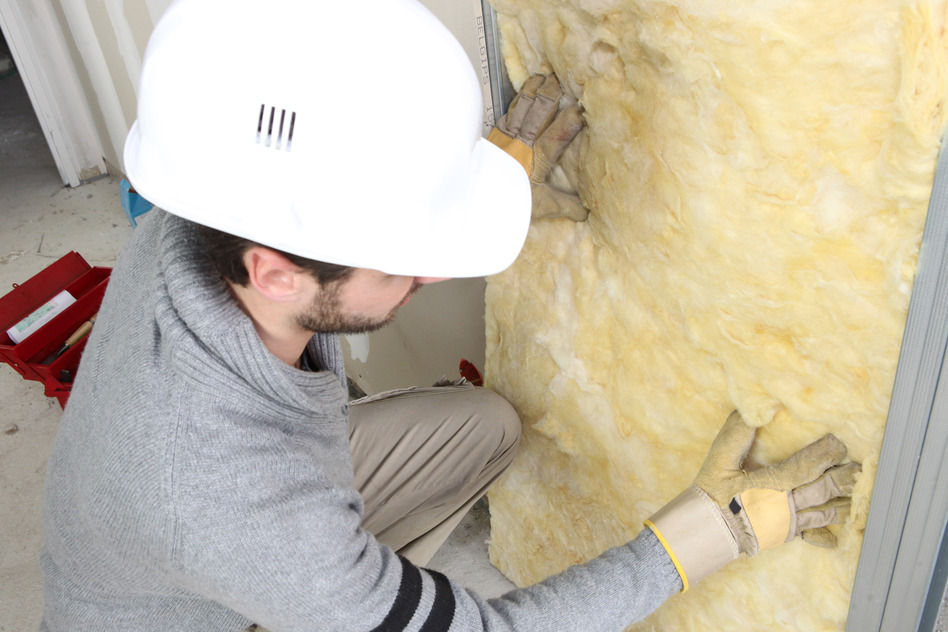We know that insulating your home isn’t the sexiest home project. But if you’re planning a remodel that includes opening up walls, ceilings, and floors, it’s a great time to upgrade your insulation to get energy savings of up to $300 per year.
However, it you’re not remodeling, think long and hard about replacing or adding wall insulation. Retrofitting wall insulation has a long payback period that should make you think twice before committing to it.
Related: The 5 Most Effective Things You Can Do to Take Back Your Energy Bills
But adding on? Finishing your basement? Redoing your kitchen? Or your attic insulation needs an upgrade? Read on to learn about the different insulation types, costs, uses, and whether you should DIY it or hire a pro.
Batts and Blankets
This is the most common type of insulation. It comes in convenient rolls that are easy to transport and carry. It’s especially suitable for do-it-yourself projects, but take care to cut the material to fit around plumbing pipes, wires, and electrical outlets. Clumsily stuffed into awkward spaces, it loses effectiveness — sometimes as much as 50%.
Fiberglass Batts and Blankets
- R-value: 3.0-4.0 per inch (R-13 for a 2-by-4-framed wall).
- Advantages: Widely available and familiar, standard widths and thicknesses are designed to fit between studs, joists, and rafters. Paper- and foil-faced versions have stapling flanges that make installation easy.
- Disadvantages: Can be itchy to install — you’ll need protective clothing. Rolls of fiberglass must be cut by hand to fit spaces. It compresses easily, which causes it to lose insulating properties.
- Environmental issues: Phenol formaldehyde, linked to cancer, is being phased out as a binder. Labels warning of possible cancer risk from inhaled fibers are being phased out because regulators have concluded the fibers break down quickly in lungs. Recycled content can be up to 60%.
- Best use: Walls, floors, ceilings.
- DIY or pro? DIY
- Cost: 30 cents per sq. ft.
Rockwool Batts and Blankets
- R-value: 4-5 per inch (R-15 for a 2-by-4-framed wall).
- Advantages: More fire-resistant than fiberglass. Doesn’t itch. Springs into shape against studs, so installation is staple-free and quick.
- Disadvantages: Not widely available; retains moisture — if allowed to get damp, it can harbor mold growth.
- Environmental issues: High recycled content, up to 90% (all pre-consumer). Contains crystalline silica, which if inhaled over a long term could cause lung disease, including cancer.
- Best use: Walls, floors, ceilings.
- DIY or pro? DIY
- Cost: 60 cents per sq. ft.
Cotton Batts (aka “Blue Jeans”)
- R-value: 3.5-4 per inch (R-13 for a 2-by-4-framed wall).
- Advantages: Doesn’t itch. Comes in easy-to-handle rolls. Simple to cut for fitting around pipes.
- Disadvantages: Not widely available and pricier than other batts.
- Environmental issues: Contains at least 85% recycled fiber and needs little additional energy to make. Contains a borate fire retardant, which also deters some insect pests.
- Best use: Walls.
- DIY or Pro: DIY
- Cost: 90 cents per sq. ft.
Loose-Fill Insulation
This insulation consists of fluffy strands of fiber blown into attics and walls with a special machine. It fills nooks and crannies, eliminating cold spots.
Loose-Fill Fiberglass
- R-value: 2.2–2.7 per inch.
- Advantages: Lightweight enough for attic applications over ½-inch drywall ceilings with framing every 24 inches.
- Disadvantages: The product is so fluffy that loose applications may lose up to half their effectiveness at very cold temperatures unless topped by blanket insulation or higher-density loose fill (see cellulose below).
- Environmental issues: Same as for fiberglass batts and blankets, except that formaldehyde isn’t an issue. Up to 60% recycled content.
- Best use: Ceilings.
- DIY or pro? Insulating an open attic space is relatively easy if you’re a competent DIYer. You’ll save up to 70% over the cost of a pro. Check to see if you can rent an insulation blower from your local home improvement center or tool rental store. But if the job is more complicated than that, definitely hire a professional to make the installation worthwhile in terms of energy savings.
- Cost: 30 cents per cubic foot.
Loose-Fill Cellulose
- R-value: 3.2–3.8 per inch.
- Advantages: Effective at all temperatures, and can even perform better as the air gets colder.
- Disadvantages: Too heavy for attic installations; ceiling must have at least 5/8-inch drywall or framing every 16 inches. Over time, it can settle almost 20%, reducing its effectiveness.
- Environmental issues: Fibers are too big to lodge in lungs; dust is only a nuisance issue. The makeup of cellulose insulation typically is around 85% post-consumer recycled paper, plus 15% fire retardant. That’s usually a borate compound, which also helps deter pests.
- Best use: Ceilings, enclosed existing wall or open new wall cavities, unfinished attic floors, other hard to reach places.
- Cost: 31 cents per cubic foot.
Structural Insulated Panels
Structural insulated panels (SIPs) have superior energy savings of 12% to 14%, but they’re also pricier. They usually come in 4-by-8-ft. sheets, although some manufacturers make them as large as 8-by-24 feet, used mostly for new construction.
If you’re replacing siding or roofing, or doing an addition, these boards will insulate the entire wall surface, including the framing. Some sheets have tongue-and-groove edges to make tight, energy-efficient seams. The insulation also is used for basementand crawl space walls. When facing a living area, building codes usually require the material to be covered with a layer of drywall.
Polystyrene SIPs
This type of SIP comes in two versions: Expanded (EPS) is the least expensive and has the lowest R-value. Extruded (XPS) type is usually blue or pink in color; it’s stronger and blocks moisture better than EPS.
- R-value: 3.8 (EPS) to 5 (XPS) per inch.
- Advantages: Lightweight, easy to install.
- Disadvantages: Must be cut to fit around pipes and other wall penetrations, leaving gaps that should be filled with sealing foam. It’s not structural — you can’t nail anything to it. Insects and pests can tunnel through them. Best to treat the panels with insecticide before using. Also, they’re so air-tight, a well-built SIP structure might need fresh-air ventilation for safety and to meet building codes.
- Environmental issues: Panels emit toxic smoke when burned. Although scraps and leftovers can be recycled, they rarely are; instead, they can wind up as plastic bead litter in rivers and oceans.
- Best use: New walls, ceilings, floors, roofs.
- DIY or pro? You can do it yourself, but since these panels are best for new or full replacement construction, you’ll likely already have a contractor on the job.
- Cost: EPS: $6 for a 1-inch-thick, 4-by-8-ft. sheet; XPS: $15 for a 1-inch-thick, 4-by-8-ft. sheet.
Polyisocyanurate SIPs
- R-value: 5.6-7.7 per inch.
- Advantages: The highest R-value per inch of any insulation with a thickness that ranges from ½ inch to 2 inches. It’s often faced with foil, which acts as a moisture barrier. Easy to install.
- Disadvantages: Because the foil type is a moisture barrier, it shouldn’t be used where there already is an interior moisture barrier. Expensive.
- Environmental issues: Panels emit toxic smoke when burned. Although scraps and leftovers can be recycled, they rarely are.
- Best use: New walls, ceilings, floors, roofs.
- DIY or pro? Same as the EPS and XPS, you’ll likely be using a contractor.
- Cost: $22 for a 1-inch-thick, 4-by-8-ft. sheet.
Spray Foam
Spray foam insulation costs more than batt insulation, but it has higher R-vlaues. It also forms an air barrier, which can eliminate some other weatherizing tasks, such as caulking.
This plastic insulation goes on as a liquid and expands to fill the available space, sealing all gaps and cracks and stopping any air leaks. Pros spray the foam insulation mixture into framing cavities; once dry, the excess is cut away, leaving a flat, even surface.
Open-Cell Polyurethane Spray Foam
- R-value: 3.5 to 3.6 per inch.
- Advantages: Stops movement of air.
- Disadvantages: Allows water vapor to pass through, so a moisture barrier is still needed in some situations. Requires professional installation.
- Environmental issues: Often called half-pound foam, this insulation contains a modest amount of petroleum-based or plant-based plastic. Chemicals and VOCs released during application and while curing can cause asthma and other serious health effects, so wait up to three days to re-enter.
- Best use: Walls, floors, ceilings.
- DIY or pro? Although DIYers can buy cans for small jobs, such as filling spaces around door framing, you need a pro with special equipment to insulate walls, the roof or attic, and floors, especially if you want to get the highest R-rating possible.
- Cost: $1 to $1.20 per sq. ft. (R-13 for a 2-by-4-framed wall).
Closed-Cell Polyurethane Spray Foam
- R-value: 6.0 to 6.5 per inch.
- Advantages: Stops movement of moisture as well as air.
- Disadvantages: Relatively expensive. Requires professional installation.
- Environmental issues: Uses blowing agents that have a high global warming potential. Often called 2-pound foam, it uses significantly more materials than open-cell foam. Exposure issues are similar to open-cell foam.
- Best use: Walls, floors, ceilings.
- DIY or pro? Definitely professional.
- Cost: $1.75 to $3 per sq. ft. (R-13 for a 2-by-4-framed wall).







